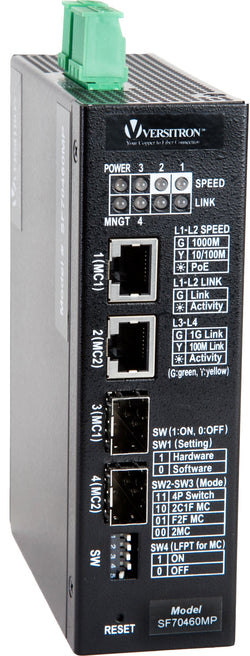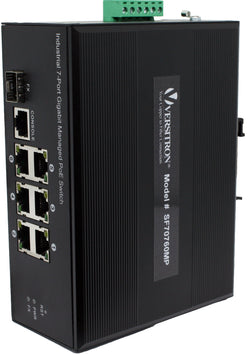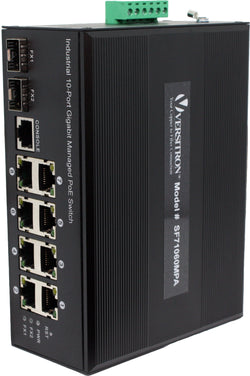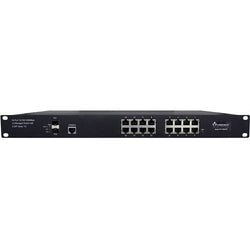PoE Switches
VERSITRON provides a range of industrial PoE network switches, many of which comply with the IEEE 802.3at-2009 PoE Standard, also known as PoE Plus.
What is PoE Switches (Power over Ethernet)?
PoE switches operate with PoE Power Sourcing Equipment technology to distribute power and data through twisted-pair or Ethernet cables concurrently. PoE switches also support dual transmission using SFP modules over fiber optic cables.
Our PoE Switches are available in various models with different port numbers (4 to 52) and managed configurations. Additionally, our PoE+ switches can support power consumption of up to 30W per port.
Managed PoE Switches Managed Industrial PoE/PoE+ Switches
PoE+ Switch vs. PoE Switch
PoE (Power over Ethernet) and PoE+ (Power over Ethernet Plus) switches both provide power to connected devices over Ethernet cables, but there are key differences between the two:
- Power Output: PoE switches comply with the IEEE 802.3af standard and can provide up to 15.4 watts of power per port. In contrast, PoE+ switches comply with the IEEE 802.3at standard and can provide up to 30 watts of power per port. This higher power output of PoE+ switches makes them suitable for powering various high-power devices, including PTZ cameras and access points with multiple radios.
- Compatibility: PoE+ switches are backward compatible with PoE devices, meaning they can power both PoE and PoE+ devices. However, PoE network switches can only power PoE devices and do not provide enough power for PoE+ devices. Cost: PoE plus switches are typically more expensive than Power over Ethernet switches due to their higher power output and additional features. However, the cost difference may be justified if you have devices that require the power output of PoE+.
- Future-Proofing: A PoE+ powered switch can be more future-proof if you plan to power up high-power devices in the future. Still, if the current devices require low power, PoE ethernet switches or a similar alternative would work well.
In summary, the main differences between PoE and PoE+ switches are the power output and compatibility with devices. PoE+ switches provide higher power output and are compatible with both PoE and PoE+ devices, making them a more versatile option for powering a variety of network devices.
Empower Your Devices with VERSITRON's PoE Switches
VERSITRON’s PoE and PoE+ switches can be used to power the following devices in an Ethernet network.
- VoIP Phones: These were among the first devices to leverage PoE. Many VoIP phones support PoE, allowing them to receive power and data over the same Ethernet cable.
- Wireless Access Points (WAPs): WAPs can be powered by PoE switches, simplifying their installation and reducing the need for additional power outlets.
- IP Cameras: Power over Ethernet switches can power IP cameras, making them easier to install in locations where power outlets are not readily available.
- Networked Audio Systems: Some networked audio systems, such as speakers and microphones, can be powered by PoE switches.
- Access Control Systems: PoE powered switches can power access control systems, including card readers and electronic locks, simplifying their installation and maintenance.
- Lighting Systems: It can power LED lighting systems, allowing for centralized control and management.
- Intercom Systems: These switches can power intercom systems, enabling communication between different areas of a building.
- Point-of-Sale (POS) Terminals: Some POS terminals can utilize PoE, simplifying setup and reducing cable clutter.
- IoT Devices: PoE switches can power many Internet of Things (IoT) devices, especially those with low power consumption.
- High-power IP Phones: Some IP phones require more power than standard PoE can provide, making PoE+ switches necessary for their operation.
- Wireless Access Points (WAPs) with High Power Requirements: WAPs that require more power to support multiple users or high-speed wireless connections can be powered by PoE+ switches.
- PTZ (Pan-Tilt-Zoom) Cameras: PTZ cameras often require more power for their motorized movement and high-resolution imaging, making PoE+ switches ideal for their operation.
- High-power IP Cameras: IP cameras with advanced features such as high-resolution imaging, infrared night vision, and motorized zoom may require more power than standard PoE can provide.
- Access Control Systems with Multiple Components: Access control systems that include multiple components, such as card readers, electronic locks, and control panels, may require more power, making PoE+ switches necessary.
- VoIP Intercom Systems: VoIP intercom systems that feature video capabilities and require more power for high-quality audio and video transmission can be powered by PoE+ switches.
- Networked Audio Systems with High-Power Speakers: Networked audio systems that include high-power speakers for audio playback may require more power than standard PoE can provide.
What are the Advantages of PoE Network Switches?
- Simplified Installation: PoE powered switches eliminate the need for separate power cables for devices such as IP phones, wireless access points, and IP cameras, simplifying installation and reducing clutter.
- Flexibility and Scalability: PoE switches allow for easy expansion of the network since new devices can be added without the need for additional power outlets.
- Cost Savings: These switches can lower installation costs and reduce overall infrastructure costs by eliminating the need for separate power supplies and cables.
- Remote Power Management: Power over Ethernet switches allow for remote monitoring and control of power usage, enabling efficient power management and troubleshooting.
- Reliability: These switches provide a reliable power source to connected devices, ensuring continuous operation even during power outages when backup power is unavailable.
- Safety: Ethernet powered switches are designed to deliver power safely, with built-in protection against overloading, short circuits, and other electrical faults.
- Energy Efficiency: PoE internet switches can help reduce energy consumption by automatically powering down devices when not in use or by adjusting power output based on device requirements.
Choosing the Right Power over Ethernet Switch
Choosing the ideal Power over Ethernet switch involves understanding your network requirements and the capabilities of different switch options. Here's a breakdown of key factors to consider.
Device Power Needs and PoE Standards: You must address your application's power requirements and budgets here.
- Power Requirements: Identify the maximum power wattage of the PoE devices you plan to connect. Common PoE standards are:
- PoE (802.3af): Delivers up to 15.4 watts, suitable for basic IP cameras and VoIP phones.
- PoE+ (802.3at): Offers up to 30 watts (usable power around 25.5 watts), powering advanced IP cameras, multi-antenna WAPs, and some POS terminals.
- PoE Budget: Ensure the switch's budget exceeds the combined wattage needs of your devices.
Network Features and Management: You have to address the features of the switch and the required data speed.
- Managed vs. Unmanaged:
- Unmanaged: These are plug-and-play switches, which are ideal for simple networks with limited configuration needs.
- Managed: These switches offer granular control over network traffic, security features, and PoE power settings, they are better suited for complex networks requiring more customization.
- Data Speed: Choose a switch with data speeds (typically 1G or 10G) that meet your network's data transfer requirements.
Additional Considerations: There are several other considerations to make in addition to the above.
- Number of Ports: PoE switches come with fiber ports and Ethernet ports. Select a switch with enough ports to accommodate all your devices with room for future expansion.
- Security Features: Managed switches might offer features like VLANs to isolate network segments for enhanced security.
- Desktop vs. Rackmount: Desktop switches are compact for smaller deployments, while rackmount switches suit high-density network environments.
Based on Complexity: Here's a simplified approach to choosing based on complexity.
- Simple Home/Small Office Network: You can choose unmanaged PoE switches with enough Gigabit ports and PoE budget for your devices (likely PoE+ for future-proofing).
- Complex Business Network: To meet demanding network requirements, you can choose managed PoE switches with advanced features, scalability, and security options.
At VERSITRON, we offer unmatched customer assistance, which in turn enables our customers to procure the correct PoE network switch that best suits their application. This commitment to quality and customer satisfaction has helped us build a worldwide base of satisfied customers over the past 60+ years. If you would like to know more about our PoE+ network switches or other fiber optic switches please feel free to call (1-800-537-2296) or open a chat with our experts. We would welcome the opportunity to work with you!








